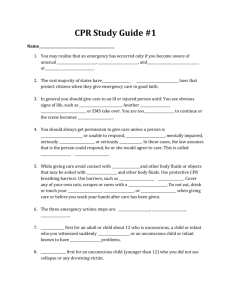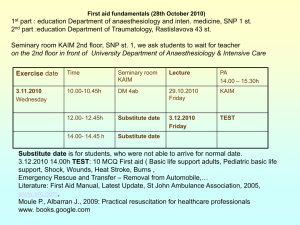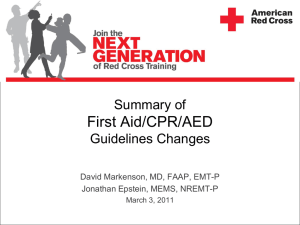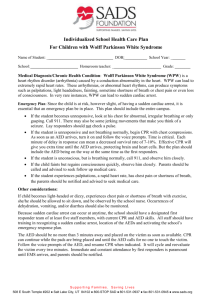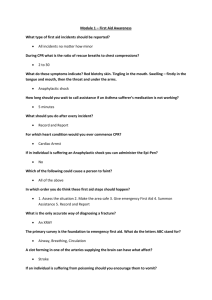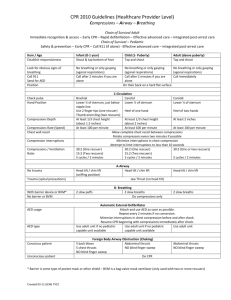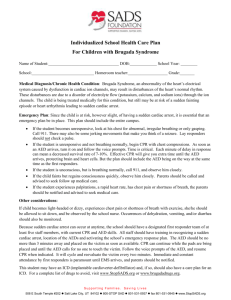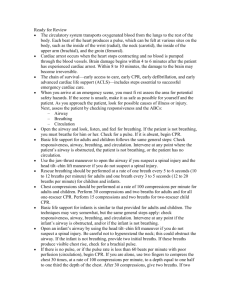Adult First Aid/CPR/AED
advertisement
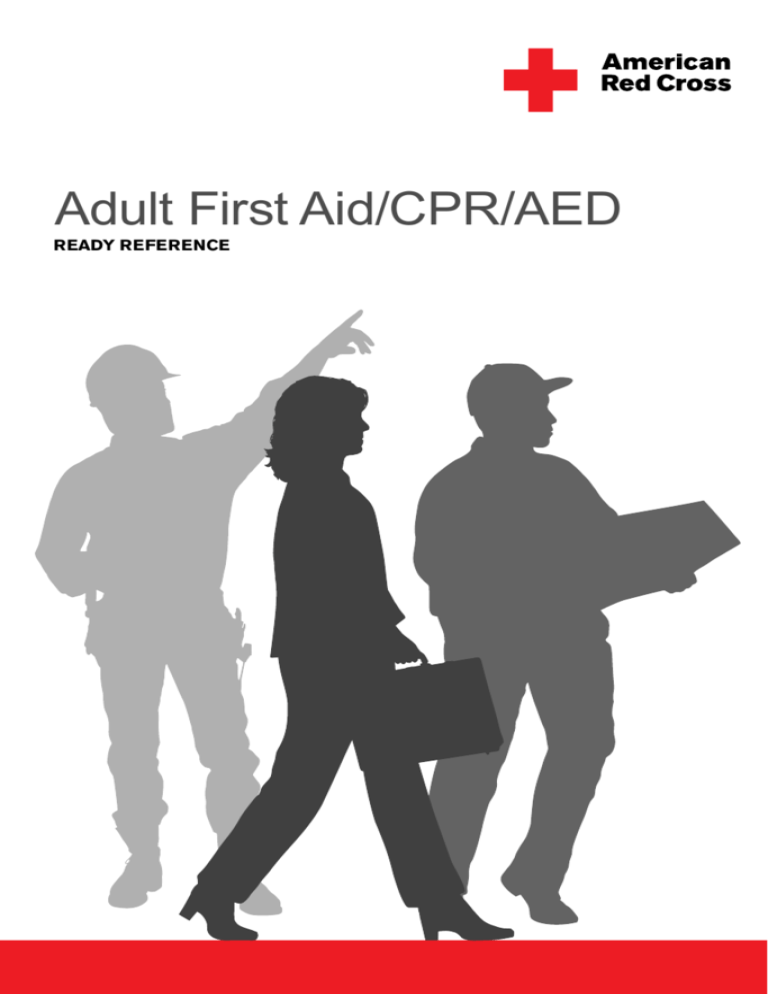
Adult First Aid/CPR/AED READY REFERENCE CHECKING AN INJURED OR ILL ADULT APPEARS TO BE UNCONSCIOUS TIP: Use disposable gloves and other personal protective equipment and obtain consent whenever giving care. AFTER CHECKING THE SCENE FOR SAFETY, CHECK THE PERSON: CHECK FOR RESPONSIVENESS Tap the shoulder and shout, “Are you OK?” CALL 9-1-1 If no response, CALL 9-1-1 or the local emergency number. ■■ If an unconscious person is face-down, roll face-up, supporting the head, neck and back in a straight line. If the person responds, obtain consent and CALL 9-1-1 or the local emergency number for any life-threatening conditions. CHECK the person from head to toe and ask questions to find out what happened. OPEN THE AIRWAY Tilt head, lift chin. PANEL 2 CHECK FOR BREATHING CHECK quickly for breathing for no more than 10 seconds. ■■ Occasional gasps are not breathing. QUICKLY SCAN FOR SEVERE BLEEDING WHAT TO DO NEXT ■■ Give CARE based on conditions found. ■■ IF NO BREATHING—Go to PANEL 6 or PANEL 7 (if an AED is immediately available). ■■ IF BREATHING—Maintain an open airway and monitor for any changes in condition. PANEL 3 CONSCIOUS CHOKING CANNOT COUGH, SPEAK OR BREATHE AFTER CHECKING THE SCENE AND THE INJURED OR ILL PERSON, HAVE SOMEONE CALL 9-1-1 AND GET CONSENT. GIVE 5 BACK BLOWS Give 5 back blows. ■■ Bend the person forward at the waist and give 5 back blows between the shoulder blades with the heel of one hand. GIVE 5 ABDOMINAL THRUSTS ■■ Place a fist with the thumb side against the middle of the person’s abdomen, just above the navel. ■■ Cover your fist with your other hand. ■■ Give 5 quick, upward abdominal thrusts. CONTINUE CARE Continue sets of 5 back blows and 5 abdominal thrusts until the: ■■ Object is forced■out. ■■ Person can cough forcefully or breathe. ■■ Person becomes unconscious. WHAT TO DO NEXT ■■ IF THE PERSON BECOMES UNCONSCIOUS—CALL 9-1-1, if not already done, and give care for an unconscious choking adult, beginning with looking for an object (PANEL 5, Step 3). PANEL 4 UNCONSCIOUS CHOKING CHEST DOES NOT RISE WITH RESCUE BREATHS AFTER CHECKING THE SCENE AND THE INJURED OR ILL PERSON: GIVE RESCUE BREATHS Retilt the head and give another rescue breath. GIVE 30 CHEST COMPRESSIONS If the chest still does not rise, give 30 chest compressions. TIP: Person must be on firm, flat surface. Remove CPR breathing barrier when giving chest compressions. LOOK FOR AND REMOVE OBJECT IF SEEN GIVE 2 RESCUE BREATHS WHAT TO DO NEXT ■■ IF BREATHS DO NOT MAKE THE CHEST RISE—Repeat steps 2 through 4. ■■ IF THE CHEST CLEARLY RISES—CHECK for breathing. Give CARE based on conditions found. PANEL 5 CPR NO BREATHING AFTER CHECKING THE SCENE AND THE INJURED OR ILL PERSON: GIVE 30 CHEST COMPRESSIONS Push hard, push fast in the middle of the chest at least 2 inches deep and at least 100 compressions per minute TIP: Person must be on firm, flat surface. GIVE 2 RESCUE BREATHS ■■ Tilt the head back and lift the chin up. ■■ Pinch the nose shut then make a complete seal over the person’s mouth. ■■ Blow in for about 1 second to make the chest clearly rise. ■■ Give rescue breaths, one after the other. Note: If chest does not rise with rescue breaths, retilt the head and give another rescue breath. DO NOT STOP Continue cycles of CPR. Do not stop CPR except in one of these situations: ■■ You find an obvious sign of life, such as breathing. ■■ An AED is ready to use. ■■ Another trained responder or EMS personnel take over. ■■ You are too exhausted to continue. ■■ The scene becomes unsafe. WHAT TO DO NEXT ■■ IF AN AED BECOMES AVAILABLE—Go to AED, PANEL 7. ■■ IF BREATHS DO NOT MAKE THE CHEST RISE— AFTER RETILTING HEAD—Go to Unconscious choking, PANEL 5. TIP: If at any time you notice an obvious sign of life, stop CPR and monitor breathing and for any changes in condition. PANEL 6 AED—ADULT OR CHILD OLDER THAN 8 YEARS OR WEIGHING MORE THAN 55 POUNDS NO BREATHING AFTER CHECKING THE SCENE AND THE INJURED OR ILL PERSON: TIP: Do not use pediatric AED pads or equipment on an adult or child older than 8 years or weighing more than 55 pounds. TURN ON AED Follow the voice and/or visual prompts. WIPE BARE CHEST DRY TIP: Remove any medication patches with a gloved hand. ATTACH PADS PANEL 7 PLUG IN CONNECTOR, IF NECESSARY STAND CLEAR Make sure no one, including you, is touching the person. ■■ Say, “EVERYONE, STAND CLEAR.” ANALYZE HEART RHYTHM Push the “analyze” button, if necessary. Let AED analyze the heart rhythm. DELIVER SHOCK If SHOCK IS ADVISED: ■■ Make sure no one, including you, is touching the person. ■■ Say, “EVERYONE, STAND CLEAR.” ■■ Push the “shock” button, if necessary. PERFORM CPR After delivering the shock, or if no shock is advised: ■■ Perform about 2 minutes (or 5 cycles) of CPR. ■■ Continue to follow the prompts of the AED. TIPS: • If at any time you notice an obvious sign of life, stop CPR and monitor breathing and for any changes in condition. • If two trained responders are present, one should perform CPR while the second responder operates the AED. PANEL 8 CONTROLLING EXTERNAL BLEEDING AFTER CHECKING THE SCENE AND THE INJURED OR ILL PERSON: COVER THE WOUND Cover the wound with a sterile dressing. APPLY DIRECT PRESSURE UNTIL BLEEDING STOPS COVER THE DRESSING WITH BANDAGE Check for circulation beyond the injury (check for feeling, warmth and color). APPLY MORE PRESSURE AND CALL 9-1-1 If the bleeding does not stop: ■■ Apply more dressings and bandages. ■■ Continue to apply additional pressure. ■■ Take steps to minimize shock. ■■ CALL 9-1-1 or the local emergency number if not already done. TIP: Wash hands with soap and water after giving care. PANEL 9 BURNS AFTER CHECKING THE SCENE AND THE INJURED OR ILL PERSON: REMOVE FROM SOURCE OF BURN COOL THE BURN Cool the burn with cold running water at least until pain is relieved. COVER LOOSELY WITH STERILE DRESSING CALL 9-1-1 CALL 9-1-1 or the local emergency number if the burn is severe or other life-threatening conditions are found. CARE FOR SHOCK PANEL 10 POISONING AFTER CHECKING THE SCENE AND THE INJURED OR ILL PERSON: CALL 9-1-1 OR POISON CONTROL HOTLINE For life-threatening conditions (such as if the person is unconscious or is not breathing, or if a change in the level of consciousness occurs), CALL 9-1-1 or the local emergency number. OR If the person is conscious and alert, CALL the National Poison Control Center (PCC) hotline at 1-800-222-1222 and follow the advice given. PROVIDE CARE Give CARE based on the conditions found. HEAD, NECK OR SPINAL INJURIES AFTER CHECKING THE SCENE AND THE INJURED OR ILL PERSON: CALL 9-1-1 OR THE LOCAL EMERGENCY NUMBER MINIMIZE MOVEMENT Minimize movement of the head, neck and spine. STABILIZE HEAD Manually stabilize the head in the position in which it was found. ■■ Provide support by placing your hands on both sides of the person’s head. ■■ If head is sharply turned to one side, DO NOT move it. PANEL 11 STROKE FOR A STROKE, THINK F.A.S.T. AFTER CHECKING THE SCENE AND THE INJURED OR ILL PERSON: THINK F.A.S.T. Face— Ask the person to smile. Does one side of face droop? Arm— Ask the person to raise both arms. Does one arm drift downward? Speech— Ask the person to repeat a simple sentence (such as, “The sky is blue.”). Is the speech slurred? Can the person repeat the sentence correctly? Time— CALL 9-1-1 immediately if you see any signals of a stroke. Try to determine the time when signals first appeared. Note the time of onset of signals and report it to the call taker or EMS personnel when they arrive. PROVIDE CARE Give CARE based on the conditions found. PANEL 12 Copyright © 2011 by The American National Red Cross Stock No. 656732
